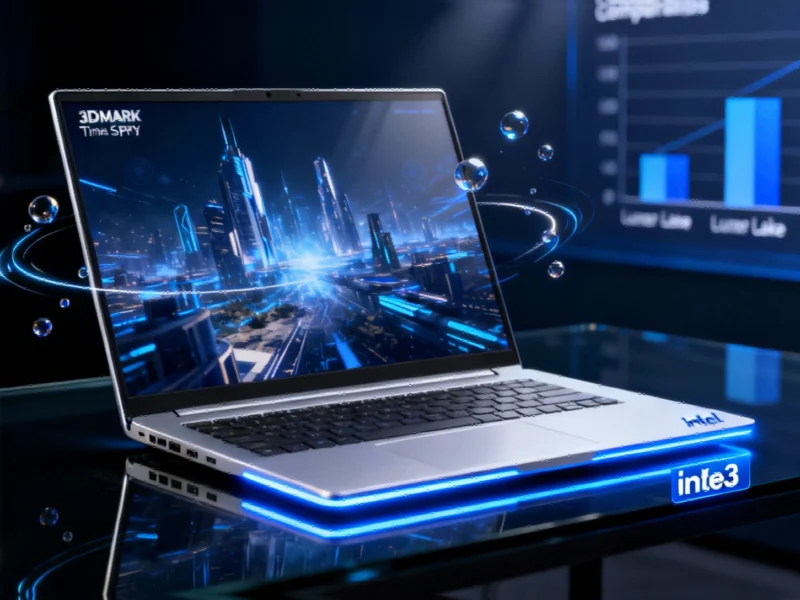Intel’s integrated graphics journey has been a rollercoaster, starting with the disappointing Xe architecture but showing remarkable improvement with Xe2 in Lunar Lake processors and Battlemage discrete GPUs. Now, leaked benchmarks suggest the company might be achieving another architectural breakthrough with its upcoming Xe3 graphics. According to a performance analysis from Industrial News Today, the Panther Lake integrated GPU is demonstrating substantial gains that could reshape the mobile computing landscape.
The leaked data originates from Chinese tech site Laptop Review Club, which tested what appears to be the flagship Core Ultra X9 388H configuration. This processor features 4 P-cores, 8 E-cores, 4 LP-cores, and twelve Xe3 graphics cores. When paired with LPDDR5-8533 memory, the system achieved a Time Spy Graphics score of 6233 points. Overclocking the memory to 9600 MT/s yielded a modest improvement to 6300 points, suggesting the chip is either power-limited or simply hitting the GPU’s performance ceiling.
Competitive Landscape and Performance Context
When placed in context, these numbers reveal a significant performance uplift. The highest recorded Lunar Lake processor score in the 3DMark database is 4505 points, with an average of 4086. This means Panther Lake’s Xe3 GPU shows approximately 38% improvement over its predecessor’s best result. The comparison becomes even more striking when looking at AMD’s competing solution – the Radeon 890M in Strix Point processors manages a maximum score of 4041 points, putting Intel’s upcoming solution roughly 54% ahead.
Perhaps most impressively, Panther Lake’s integrated graphics appears to surpass the mobile GeForce RTX 3050, which has a highest-ever graphics score of 6148 points in the same benchmark. This development comes at a time when global technology supply chains face increasing pressure that could impact component availability and pricing across the industry.
Architectural Efficiency and Scaling Analysis
Intel’s performance claims appear to align with these leaked results. The company has stated that Panther Lake’s Xe3 integrated GPU offers “>50%” higher performance compared to Lunar Lake’s integrated graphics. However, this impressive gain comes with important context – the Xe3 GPU in Panther Lake is 50% larger than the GPU in Lunar Lake, meaning much of the performance improvement stems from increased core count rather than architectural efficiency alone.
The efficiency story becomes more nuanced when examining Intel’s claims about performance per watt. The company states improvements of “more than 40%” over Arrow Lake’s performance per watt, though it’s crucial to remember that Arrow Lake uses an Xe-LPG+ architecture rather than the more advanced Xe2 found in Lunar Lake. When comparing directly to Lunar Lake, the efficiency gains appear more modest, likely in the 10-15% range. These developments occur against a backdrop where manufacturing partners are working to maintain confidence in next-generation production capabilities.
Market Implications and Verification Considerations
If these benchmarks prove accurate, Intel could significantly disrupt the mobile GPU market. An integrated solution that outperforms entry-level discrete graphics like the RTX 3050 would represent a major achievement, potentially changing how system integrators design mid-range laptops and how consumers evaluate graphics performance in thin-and-light devices.
However, experienced observers recommend cautious interpretation of these results. As with many pre-release benchmarks, several factors warrant consideration. Intel GPUs have historically shown stronger performance in synthetic benchmarks like 3DMark compared to real-world gaming scenarios. The test conditions, including thermal management and power delivery, may not reflect typical consumer usage patterns. Additionally, broader economic conditions affecting technology investment could influence final product positioning and availability.
Production Timeline and Industry Impact
Intel is currently in volume production of Panther Lake processors using its in-house 18A process node. This advanced manufacturing technology likely contributes to the performance and efficiency improvements demonstrated in these early benchmarks. The combination of architectural refinements in Xe3 and process node advantages could position Intel strongly in the competitive mobile processor market.
The technology sector continues to watch these developments closely, particularly as industry leadership dynamics evolve amid strategic shifts. As Panther Lake approaches market availability, the real test will come from independent reviews and comprehensive gaming benchmarks that validate whether these impressive synthetic results translate to tangible benefits for consumers and professionals alike.
While the leaked Time Spy scores certainly generate excitement, the ultimate measure of Panther Lake’s success will depend on real-world performance across diverse applications, driver maturity, power efficiency in actual devices, and competitive pricing. If Intel can deliver on the promise shown in these early benchmarks, the mobile computing landscape could see a significant shift in the coming year.
Based on reporting by {‘uri’: ‘hothardware.com’, ‘dataType’: ‘news’, ‘title’: ‘HotHardware’, ‘description’: ‘HotHardware is your trusted source for technology news and expert reviews of computers, PC components, laptops, tablets, smartphones and gadgets for enthusiasts, consumers, gamers and IT pros’, ‘location’: {‘type’: ‘place’, ‘geoNamesId’: ‘4930956’, ‘label’: {‘eng’: ‘Boston’}, ‘population’: 617594, ‘lat’: 42.35843, ‘long’: -71.05977, ‘country’: {‘type’: ‘country’, ‘geoNamesId’: ‘6252001’, ‘label’: {‘eng’: ‘United States’}, ‘population’: 310232863, ‘lat’: 39.76, ‘long’: -98.5, ‘area’: 9629091, ‘continent’: ‘Noth America’}}, ‘locationValidated’: False, ‘ranking’: {‘importanceRank’: 338734, ‘alexaGlobalRank’: 57783, ‘alexaCountryRank’: 28985}}. This article aggregates information from publicly available sources. All trademarks and copyrights belong to their respective owners.



